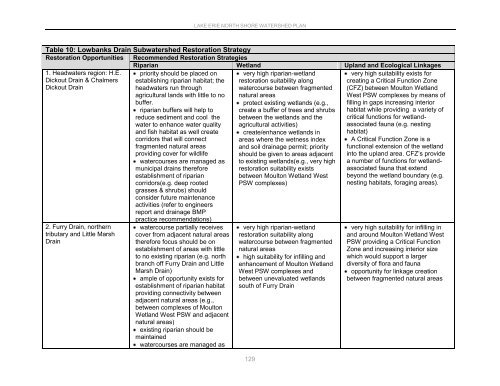Lake Erie North Shore Watershed Plan - Niagara Peninsula ...
Lake Erie North Shore Watershed Plan - Niagara Peninsula ...
Lake Erie North Shore Watershed Plan - Niagara Peninsula ...
You also want an ePaper? Increase the reach of your titles
YUMPU automatically turns print PDFs into web optimized ePapers that Google loves.
LAKE ERIE NORTH SHORE WATERSHED PLAN<br />
Table 10: Lowbanks Drain Subwatershed Restoration Strategy<br />
Restoration Opportunities Recommended Restoration Strategies<br />
Riparian Wetland Upland and Ecological Linkages<br />
1. Headwaters region: H.E.<br />
Dickout Drain & Chalmers<br />
Dickout Drain<br />
2. Furry Drain, northern<br />
tributary and Little Marsh<br />
Drain<br />
priority should be placed on<br />
establishing riparian habitat; the<br />
headwaters run through<br />
agricultural lands with little to no<br />
buffer.<br />
riparian buffers will help to<br />
reduce sediment and cool the<br />
water to enhance water quality<br />
and fish habitat as well create<br />
corridors that will connect<br />
fragmented natural areas<br />
providing cover for wildlife<br />
watercourses are managed as<br />
municipal drains therefore<br />
establishment of riparian<br />
corridors(e.g. deep rooted<br />
grasses & shrubs) should<br />
consider future maintenance<br />
activities (refer to engineers<br />
report and drainage BMP<br />
practice recommendations)<br />
watercourse partially receives<br />
cover from adjacent natural areas<br />
therefore focus should be on<br />
establishment of areas with little<br />
to no existing riparian (e.g. north<br />
branch off Furry Drain and Little<br />
Marsh Drain)<br />
ample of opportunity exists for<br />
establishment of riparian habitat<br />
providing connectivity between<br />
adjacent natural areas (e.g.,<br />
between complexes of Moulton<br />
Wetland West PSW and adjacent<br />
natural areas)<br />
existing riparian should be<br />
maintained<br />
watercourses are managed as<br />
very high riparian-wetland<br />
restoration suitability along<br />
watercourse between fragmented<br />
natural areas<br />
protect existing wetlands (e.g.,<br />
create a buffer of trees and shrubs<br />
between the wetlands and the<br />
agricultural activities)<br />
create/enhance wetlands in<br />
areas where the wetness index<br />
and soil drainage permit; priority<br />
should be given to areas adjacent<br />
to existing wetlands(e.g., very high<br />
restoration suitability exists<br />
between Moulton Wetland West<br />
PSW complexes)<br />
very high riparian-wetland<br />
restoration suitability along<br />
watercourse between fragmented<br />
natural areas<br />
high suitability for infilling and<br />
enhancement of Moulton Wetland<br />
West PSW complexes and<br />
between unevaluated wetlands<br />
south of Furry Drain<br />
129<br />
very high suitability exists for<br />
creating a Critical Function Zone<br />
(CFZ) between Moulton Wetland<br />
West PSW complexes by means of<br />
filling in gaps increasing interior<br />
habitat while providing a variety of<br />
critical functions for wetlandassociated<br />
fauna (e.g. nesting<br />
habitat)<br />
A Critical Function Zone is a<br />
functional extension of the wetland<br />
into the upland area. CFZ‟s provide<br />
a number of functions for wetlandassociated<br />
fauna that extend<br />
beyond the wetland boundary (e.g.<br />
nesting habitats, foraging areas).<br />
very high suitability for infilling in<br />
and around Moulton Wetland West<br />
PSW providing a Critical Function<br />
Zone and increasing interior size<br />
which would support a larger<br />
diversity of flora and fauna<br />
opportunity for linkage creation<br />
between fragmented natural areas
















